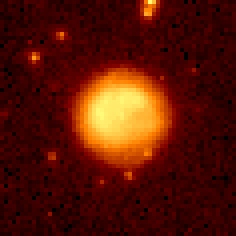
|
SMC-J-3
This round PN has a bright hemisphere of emission to the NE, making
the whole quite asymmetric in appearance.
H-alpha and [O III] are very strong, but [N II] is fairly weak; these
lines all show the same morphological structures.
[S II] and He I, are also present but very weak, and
[O I] 6300 may be marginally detected.
The CS may be detected in the continuum image.
|

|
SMC-J-4
This object is not very well resolved.
The field is crowded, making the ID on the clear image a little
uncertain. I think it is at X=542, Y=511. The spectrum is
reasonably well exposed, and shows pretty much all the lines: H-beta,
[O III] 4959+5007, [O I] 6300+63, [S III] 6312, [N II] 6548+83,
H-alpha, He I 6678, and [S II].
|

|
SMC-J-8
This bipolar PN has a distinct dark band that divides the bright core into
two, unequal lobes. This looks very much like a case of a strong bipolar
ring, viewed some distance from the plane. A faint bipolar structure is
even evident up to 2 arcsec from the center (particularly to the
south), but the ribbed, fan-like structure is projected off-center on the
sky.
H-alpha and [O III] are very strong, but [N II] is fairly weak; these
lines all show the same morphological structures.
[S II] and He I, are also present but very weak, and
[O I] 6300 may be marginally detected.
The CS may be detected in the continuum image, and possibly also
in the G750M spectrum.
|

|
SMC-J-11
This round PN is barely resolved. Its appearance is nearly stellar in
the continuum, but appears shell- or ring-like in the lower ionization
lines.
H-alpha and [O III] are very strong, but [N II], He I, and [S II]
are very weak but detected. Also weak are [O I] 6300, 6363, and
[S III] 6312.
The CS may be detected in the continuum image.
|
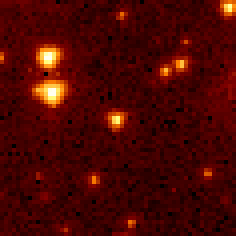
|
SMC-J-23
This object is apparently spatially unresolved, and the ID
on the clear image is difficult. (Recall that we did not take
wavecals or an image through the slit to save on overhead.) Based
on the MSM repeatability & the positions of the continuous spectra,
I suspect the PN is at X=505, Y=522 in the image. Will have to
verify that. The spectrum shows strong and broad H-alpha, somewhat
weaker & broad [N II], and detectible He I 6678. No [S II], and
no [O I]. We don't have a G430M spectrum. I haven't had a chance
to measure the H-alpha velocity width yet, but it appears to be
~200-300 km/s. Pretty broad for a PN. Boroson & Liebert (1989)
also noted a peculiar spectrum (v. strong He II and weak [O III],
as I recall), but doubted it could be a symbiotic with a Giant
companion as the red stellar continuum would have been apparent.
Perhaps a symbiotic with a M.S. companion? If it is a PN, maybe
the H-alpha flux has changed since B&L published their spectra?
|
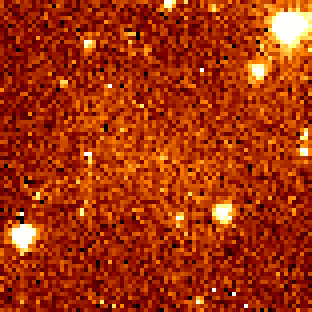
|
SMC-J-27
This object is roughly box-shaped, and may be the remnant of a bipolar.
The nebula is barely detected in the broad-band exposure, at roughly
20 counts/pixel above the background. The spectrum shows faint [N II]
emission, with some hint of H-alpha emission. The G750M exposure was
only about one-quarter of the desired duration, but was nonetheless
about as long as could be accomodated in a SNAPSHOT.
No central star is detected.
|

|
SMC-MA-1682
This is an extreme bipolar PN, with a prominent central ring.
The H-alpha and [N II] lines are very strong in the spectrum, and
[S II] is barely detected; no other lines are detected.
We don't have a blue spectrum for this one, so no measurement of [O III].
The CS is easily detected in the continuum image.
|

|
SMC-MA-1762
This is an elliptical PN, with a mildly bi-nebulous inner core.
No lines other than H-alpha are detected in the spectrum:
no [N II], no He I, etc. We don't have a blue spectrum for this
one, so no measurement of [O III].
The CS is easily detected in the continuum image.
|

|
SMC-MG-08
This elliptical PN has a very distinct ring structure, with a hint of
ansae that extend ~0.1 arcsec along the major axis from the 10% contour.
H-alpha is very strong, and [N II] is apparent but weaker, and
[S II] is very weak. No other lines are detected in the G750M
spectrum. H-beta is well exposed, and [O III] is only a bit
stronger. The morphology in [O III] different in detail, in
that the emission comes primarily from a ring that is inside the
emission from most other lines. An ionization map would be interesting.
The CS is exceptionally bright in the continuum image; could it be a
MS binary companion to the true CS?
|
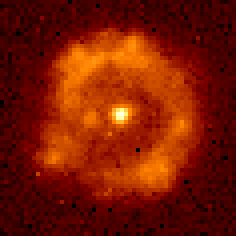
|
SMC-MG-13
This elliptical PN has a very knotty ring structure, with ansae
that extend ~0.3 arcsec from the 10% contour.
H-alpha is very strong, but neither [N II] nor any other line is
detected in the G750M spectrum.
The CS is easily detected in the continuum image.
|
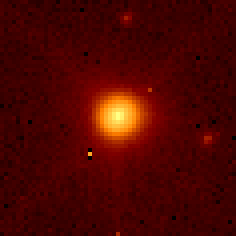
|
SMC-SMP-08
This is a round PN, with somewhat elliptical inner contours.
H-alpha and [O III] are very strong, with [N II] and He I at the ~1% level,
and [S II] weaker still. [O I] is absent.
The CS is detected in the continuum image, but there is a significant
contribution from the nebular emission.
|

|
SMC-SMP-14
This round PN has a distinctly bi-nebulous inner core, and faint ansae
that extend ~0.3 arcsec from the 10% contour, along a line roughly 45°
from the axis of symmetry defined by the lobes.
H-alpha is very strong, and [N II] is detected in the spectrum, but is
very weak. [S II] and He I, are also present but weak.
[O III] is quite strong.
The CS is easily detected in the continuum image.
|
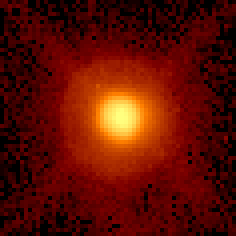
|
SMC-SMP-17
This is a round PN, with a very faint outer halo that is detected in the
continuum image, in H-alpha, and in [O III] at the ~0.4% contour level.
The inner portion is somewhat elliptical in all the observed lines except
[N II], where it is ring-like.
H-alpha is very strong, and [N II] is present but very weak.
The CS is detected in the continuum image, but there is a significant
contribution from the nebular emission.
|

|
SMC-SMP-20
This PN is bright but unresolved.
H-alpha and [O III] are very strong, with [N II] at the ~1% level, and
He I, [S II], and [O I] weaker still.
The CS is detected in the continuum image, but there is a significant
contribution from the nebular emission.
|
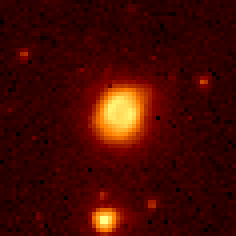
|
SMC-SMP-26
This is a very small point-symmetric PN two arms that extend from the
NE and SW of the center.
H-alpha is fairly strong, but [N II] is nearly as bright, and shows
the arms much more clearly.
No CS is detected in the continuum image.
|

|
SMC-SMP-27
This is a round PN, with somewhat elliptical inner contours.
H-alpha and [O III] are very strong, with [N II] at the ~1% level, and
He I, [S II], and [O I] weaker still.
The CS is detected in the continuum image, but there is a significant
contribution from the nebular emission.
|

|
SMC-SP-34
This is a round PN, with a faint outer halo that is detected in the
continuum image and in H-alpha, at the 5% contour level.
The inner portion shows significant asymmetry in all the
observed lines, in that the western edge is much brighter.
H-alpha is fairly strong, and [N II] is present but much weaker.
No CS is detected in the continuum image.
|

